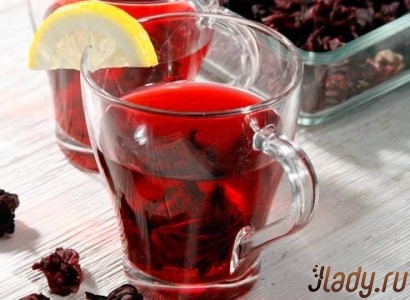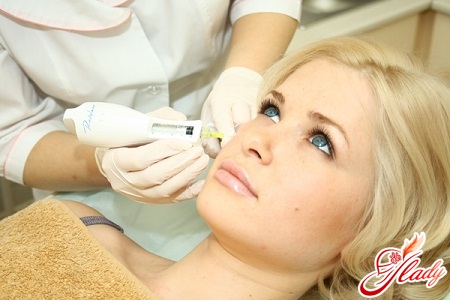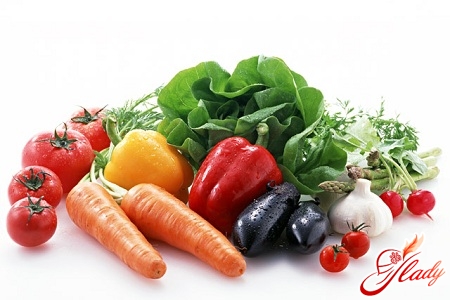 Hibiscus tea has been known since the time of the pharaohs.The Sudanese rose, from whose petals it is prepared, has powerful antioxidant and stimulating properties. In fact, it is hibiscus, which has long been known in northern Africa. The popularity of karkade in the summer months increases quite strongly. And no wonder, because it is difficult to find a better time to drink drinks using the Sudanese rose. Hibiscus tea is very pleasant to drink, especially in the heat, because it can be prepared both hot and very cold. It has a luxurious taste, sweet and sour at the same time. This drink is officially recognized as a national drink in Egypt. And it is no coincidence, because the natives prepare wonderful tea from the petals of a plant called hibiscus.
Hibiscus tea has been known since the time of the pharaohs.The Sudanese rose, from whose petals it is prepared, has powerful antioxidant and stimulating properties. In fact, it is hibiscus, which has long been known in northern Africa. The popularity of karkade in the summer months increases quite strongly. And no wonder, because it is difficult to find a better time to drink drinks using the Sudanese rose. Hibiscus tea is very pleasant to drink, especially in the heat, because it can be prepared both hot and very cold. It has a luxurious taste, sweet and sour at the same time. This drink is officially recognized as a national drink in Egypt. And it is no coincidence, because the natives prepare wonderful tea from the petals of a plant called hibiscus.
Some useful information
Hibiscus belongs to the mallow family.This family is characterized by luxurious flowering and very bright, fragrant flowers. Hibiscus is a very unpretentious and grateful plant. It can be grown absolutely easily even at home. It grows in many countries. Egypt is considered its homeland first of all. But hibiscus is also found in China, Mexico, Thailand, Java and Ceylon. So it can be said that this plant is international. Moreover, in every corner of the world hibiscus has its own name:
- in the countries of Africa it is called Sudanese tea
- in Jamaica - red sorrel or roselle
- in Mexico - flor de Jamaica
Hibiscus has more than 150 varieties andgrows in various forms: as a lush bush or a tall tree. Hibiscus Sabdariffa is used to make tea. The first mentions of hibiscus tea can be found back in 1576, in the works of a certain Mattias de L’Obel, a botanist who documented the existence of this healing drink. Sudanese rose is a plant that is not only aromatic and tasty, but also very useful. The amount of useful substances, vitamins, microelements and acids of organic origin is very large. A drink that contains hibiscus has a pleasant sour taste and aroma, which indicates the presence of a fairly large amount of citric acid in such tea. In general, hibiscus is a name that has its roots in Africa. It is also called red sorrel, Sudanese rose or Venice mallow. It is worth noting that not everyone shares the ardent love of Egyptians and other African peoples for hibiscus. Some people are very negative about tea, which contains even a small amount of hibiscus. Meanwhile, true connoisseurs of refined taste and healthy eating, note not only its wonderful properties, but also the amazing effect that can be achieved by regularly consuming it. Hibiscus is a very grateful product that helps us maintain health, youth and energy. It is absolutely natural, because in order to grow it, it is not necessary to use fertilizers. Any of the one hundred and fifty species of this plant can absolutely easily grow in different parts of the world, only the climate must be warm and tropical. But the best is still considered to be the hibiscus that grows in Egypt.
Useful properties of carcade
Hibiscus has a number of beneficial properties.It contains anthocyanins - special substances that give the leaves of the flower a luxurious red hue. These components are distinguished by a very high concentration of vitamin P, which is responsible for normalizing blood pressure and improving the condition of blood vessels. If you have high blood pressure, then drink cold hibiscus tea, and if low - hot, using our recipes. It is useful to drink hibiscus even during pregnancy. Hibiscus has antispasmodic and diuretic properties. In addition, the effect of known anthocyanins on the body is enhanced by quercetin - another invaluable substance contained in hibiscus leaves. Both of these elements work great as powerful stimulants for cleansing and toning the entire body as a whole. In addition, the resistance of the liver increases, its walls and protective functions are strengthened, which is caused by the influx of bile. And therefore, immunity and metabolism are strengthened. The cups should be collected at dawn. After that, they are dried for three or four days in the open air. After this, the hibiscus petals can be considered fit for consumption. Although you can eat not only the cups and petals of hibiscus. Seeds, leaves, roots - everything is good for the future and serves to benefit human health. There are practically no contraindications in this case. As with everything, when taking hibiscus, you should not get too carried away and drink it in very large quantities. Hibiscus is also used to get rid of parasites. How does it work? Due to the absence of oxalic acid in it, hibiscus can be used even by those people who have kidney problems. It is very useful to take directly the hibiscus that remains after you have brewed tea. It is useful to simply chew these leaves in small quantities. The healing properties of hibiscus do not decrease at all, and their delicate and pleasant taste and smell will make you think about something pleasant. Hibiscus is quite good at relieving any inflammatory processes in the body. It promotes digestion and increases appetite, having a beneficial effect on the entire gastrointestinal tract. In addition, it calms the nervous system and improves sleep. It is a fairly powerful psychostimulant that helps cope with many problems that arise due to stress, nervous disorders or mental strain. Hibiscus is good for the pancreas. The drink hibiscus helps get rid of not only toxins, but also cholesterol. It relieves migraines and helps with hangovers. Sudanese rose copes with fever quite well. Hypertensive patients can drink this drink as a means of normalizing blood pressure. However, you should not get carried away with it, as it can have the opposite effect. If you have urolithiasis or problems with the gallbladder, then hibiscus should also be put aside. In general, this drink is very useful and helps quench thirst wonderfully, as it has a sour taste. Sudanese rose contains:
- protein – 7.5 — 9.5%
- amino acids - 13 species, six of which are extremely necessary for health
- pectin - 2.4%
By the way, the last element helps remove toxins and heavy metals from the intestines and the entire human body.
How to make delicious and healthy tea
Hibiscus is absolutely versatile.You can cook absolutely everything from it. Hibiscus is a great addition to many salad recipes. Its seeds are used to make delicious coffee or added to soup for more flavor and piquancy. Only they need to be pre-fried. Wines and tinctures are made from the petals, sweet syrups, puddings and delicious marinades are cooked. The calyxes of the flower itself are suitable for making sherbet, cake, ice cream or jelly. And from the root itself they manage to create pipes. Sudanese healers and doctors advised tea with hibiscus added to it for almost any disease. And modern discoveries and research only once again convince us of the correctness of healers and the power of hibiscus. However, in order for hibiscus not to lose its medicinal qualities and properties, it should be prepared in a special way, adhering to certain rules. Sudanese rose should never be brought to a boil or boiled. If you overcook hibiscus, the drink will lose its attractive color and become grayish-dirty. In principle, hibiscus can be brewed like regular tea, simply pouring hot water over some dry hibiscus leaves. Just do not use metal utensils, as they will simply destroy both the color and taste of the tea. Properly brewed hibiscus should be ruby, bright red. Hibiscus is usually served with sugar. It tastes much better this way. It is recommended to eat it with the same flowers that were brewed before. Store dried hibiscus flowers away from moisture and light, in an impermeable container. Sudanese rose allows you to prepare several types of tea and drinks. As we said above, hibiscus tea can be served both hot and cold.
Recipe one "Classic"
- 2 teaspoons of leaves of the Sudanese rose
- 150 ml of boiling water
To make a wonderful and healthy teaHibiscus tea will take you very little time. Just brew pink leaves in boiling water in proportion. You will need two teaspoons of dry leaves per 150 milliliters of boiling water. Leave to brew for about five minutes. Important: The dishes in which you brew it and the quality of the water play a big role in how your drink will taste. It is best to take the softest and cleanest water. And it is recommended to brew hibiscus itself exclusively in glass or porcelain dishes. Do not use metal dishes, as the tea will simply turn green. The main quality of properly prepared hibiscus tea can be called a sweetish taste and aroma. In hot weather, leave the brewed tea in the refrigerator for a few hours, and then put some ice in the glasses. It not only refreshes perfectly, but also tones, gives vigor, strength and energy.
Recipe for the second "Cold"
This version of making hibiscus will takeat least eight hours. Simply pour the required amount of rose petals with cold water and put them in the refrigerator for about eight hours to steep. If you leave the hibiscus tea overnight, then in the morning on a hot summer day you will have the opportunity to drink a cold and invigorating drink. Summer is generally a great time to drink hibiscus. It can be consumed not only in its pure form. Hibiscus can be added to dried fruit or fresh fruit compote. The drink will not only be enriched with a huge number of useful vitamins, minerals and substances, acquiring a pleasant, slightly sour taste and delicate aroma of roses, but will also become much more attractive due to the coloring effect.
Recipe for the third "Sudanese"
Hibiscus should be placed in cold water fortwo days. After that, strain and drink. No need to boil it. And here is another recipe in which a ready-made infusion of Sudanese rose leaves is used as a component.
Cocktail "Health"
You will need:
- strong broth of fresh crockery - 4 cups
- lime juice - one or two
- freshly squeezed, natural orange juice - 1 glass
- ginger, pre-grated on a fine grater - 1 teaspoon
- orange peel - 2 teaspoons
- sugar
All the above components should bemix in one bowl, gradually bring to a boil and simmer for exactly three minutes, after which the broth should be carefully strained, add sugar to taste and drink to your health.
Hibiscus in different countries
Now let's go on a journey afterhibiscus and find out how it is treated in certain countries of the world. Philippines Here hibiscus is used as an excellent means for stimulating appetite. First, the hibiscus root, which is very bitter to the taste, is peeled, fried and ground. Burma In Burma, hibiscus has an extremely important purpose. Here it is considered a powerful aphrodisiac and generally has almost magical properties. Guinea In this country, Sudanese rose is considered a fairly powerful sedative, and also copes well with stomach disorders, such as diarrhea. Angola Hibiscus is applied directly to wounds here, as it is believed that it has antibacterial, disinfectant and healing properties. Juice was first obtained from the leaves of this plant, which is distinguished by its rather dense consistency and thickness. India In the west of this country, Sudanese rose is put into jelly, pudding, sherbet, curry or syrups. Pre-soaked rose petals for several hours will perfectly complement the recipe of almost any salad, adding piquancy and sourness. Senegal This country supplies hibiscus to Europe in the form of huge balls, 80 kilograms each. In Europe, Sudanese rose is used in food, cosmetics, pharmaceutical and industrial production. In addition, hibiscus in some countries is simply fried with onions. In general, this plant is widely used in cooking, both fresh and dried. It is perfect as a natural food coloring. We recommend reading:









